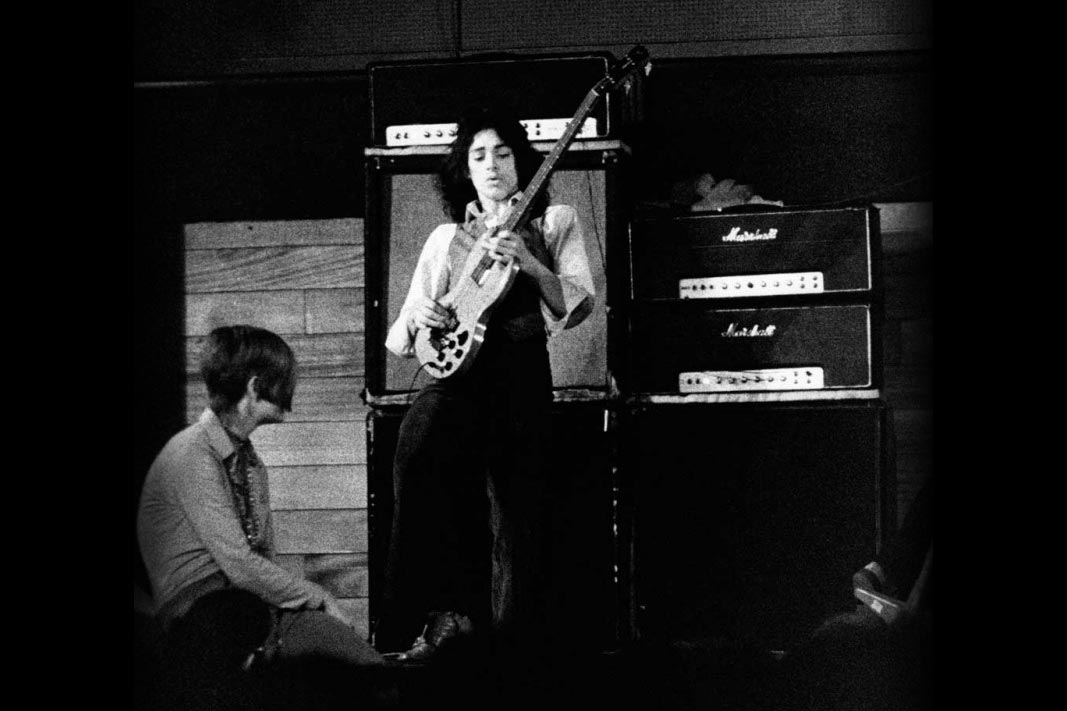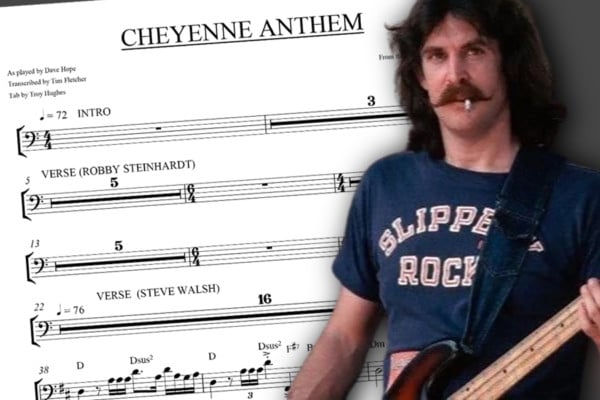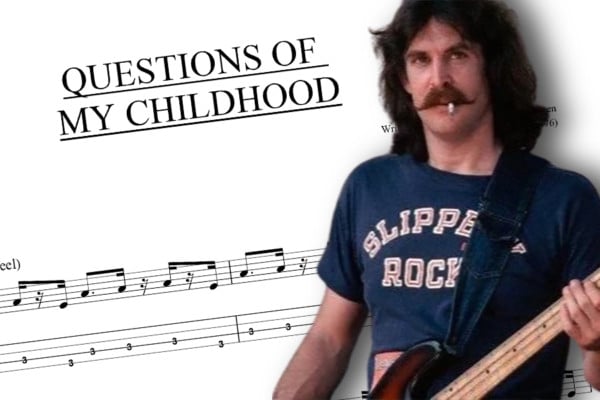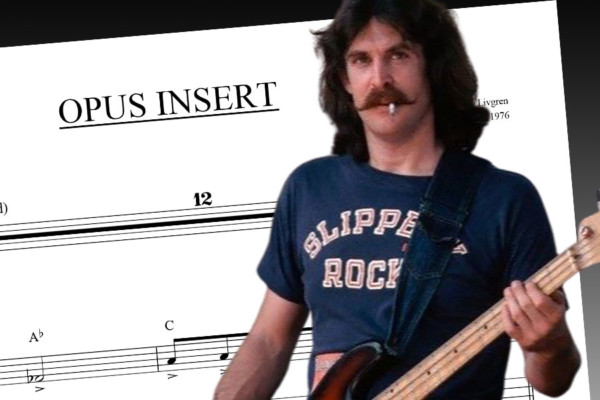Bass Transcription: Andy Fraser’s Bass Line on “Mr. Big” by Free

Free was formed in 1968 in London, and they followed in the footsteps of bands such as Cream and Fleetwood Mac, who grew out of the British Blues Explosion of the mid-sixties. By moving away from some of the restrictions of the genre, Free (alongside Led Zeppelin, Black Sabbath, and Deep Purple), helped to define British heavy rock music of the early 70s. Although the band had a relatively brief career, by the time they finally split up in 1973 they had sold 20 million albums and played 700 gigs.
Andy Fraser was born in Paddington, West London in 1952, and as a young child, he learned classical piano. By the age of 13 he had also started to play guitar, and encouraged by his father to listen to calypso and reggae music, he was soon playing gigs in West Indian clubs in the East End of London. After being expelled from school for refusing to cut his hair, Fraser enrolled at the more liberally-minded Hammersmith College where he befriended the daughter of legendary British Blues guitarist Alexis Korner. Through this connection, Korner briefly took him on as a bassist, but soon Fraser was drafted into John Mayall’s Bluesbreakers. This band was a home to many great British musicians including Eric Clapton, Mick Fleetwood, Mick Taylor and Peter Green. Fraser’s tenure in this band was again brief, as he was recommended by Korner to be the bassist in the newly formed blues-rock band Free.
The members of Free were surprisingly young when the band formed; vocalist Paul Rodgers (previously in The Roadrunners with Bruce Thomas of The Attractions) was eighteen, as was drummer Simon Kirke. Guitarist Paul Kossoff was seventeen and bassist Andy Fraser was a mere fifteen years old. The band signed to Island records in 1968, and although their first two albums Tons of Sobs and Free (both 1969) did not sell particularly well, they established themselves as a major live act by relentless gigging around the UK and Europe. Fraser co-wrote most of the material for the band, including their best-known hit “Alright Now” (1970). This track topped the charts in many countries, and helped their third album Fire and Water to reach number two in the UK and seventeen in the USA. After this success, however, the band found it difficult to replicate the sales of either the album or single, and their record label become impatient for another hit. This, along with tensions between Fraser and Rodgers, led to the band briefly breaking up in early 1971.
The members soon formed other groups, but these were not particularly successful, and Free re-formed at the start of 1972, partially to help give Kossoff a distraction from his drug habit, but this was unsuccessful. Kossoff’s continued unreliability led to Fraser leaving the band in July 1972, and he was replaced with bassist Tetsu Yamauchi. Soon Kossoff was fired and replaced by Wendell Richardson, but the magic had gone, and the band soon ceased performing and recording.
After he left Free, Fraser formed the band Sharks and played on their first album First Water (1973), but left the band just after its release. He then formed The Andy Fraser Band which released two LPs Andy Fraser Band and In Your Eyes (both 1975). Fraser later moved to California and turned his talents to songwriting, composing material for other artists including Joe Cocker, Robert Palmer, Rod Stewart and Paul Young, and he also wrote the 2008 Obama campaign song “Obama (yes we can)”. He recorded three further solo albums; Fine, Fine Line (1984), Naked…and Finally Free (2005). Fraser’s last live appearances were with Tobi Earnshaw on a UK tour in 2013, and sadly, after recording his last album On Assignment (2015), he died from a heart attack.
Fraser never saw himself as just a bassist, but a musician that could play a variety of instruments to create “whatever was needed” for the song, and he claimed that he originally only played bass as nobody else in his school band wanted to do it. He cites British rockers Paul McCartney, John Entwistle, Bill Wyman and Jack Bruce as being role models, but also considers James Jamerson and Carol Kaye as important influences in his sound and style. He played a Gibson EB3 for much of his time with Free, but also used Epiphone Rivoli semi-acoustic basses and later in his career he used Tobias, Warwick, and a Peavey Midibass.
“Mr. Big” starts with four bars of drum groove, and then Paul Kossoff’s simple, but effective E7#9 guitar riff enters. Kossoff was strongly influenced by Jimi Hendrix and may have borrowed this idea from him. The bass joins in at bar 9, with Andy Fraser’s simple root/fifth/octave (E/B/E) reverse idea generally followed by sliding off a twelfth fret G (I guess we should call this F## if we are to consider it the #9 of E, but calling it by its enharmonic equivalent, “G” is more straightforward). Fraser occasionally alternates this idea by sometimes using an E at the end of the bar, and also adds in a C# to match the vocal melody in bar 15 and a B to C# slide in bar 18. The choruses are simple, with E and B power chords used to fatten out the sound; notice how he uses an inversion of the B5 chord to avoid too much muddiness down the bottom of the neck. The next verse includes some more variation of the end of the bar licks, including a hammer-on and pull-off idea at bar 31. The second chorus leads into a guitar solo, and Fraser again fattens the sound using power chords of E5 and D5.
Fraser has stated that the bass solo on “Mr. Big” was developed over time, with a short improvisation gradually becoming more extended, and live performances allowed Fraser to stretch out the improvised section to the lengths of the recorded version. The bass solo begins at bar 63 and the chord sequence for the guitar solo is continued under Fraser’s line.
The bass solo is quite long, and contains many interesting ideas:
- The initial entry is a semi-chromatic line (you may know this as the “Satriani warm-up”) starting on the second semiquaver of beat 1 but becomes an E Mixolydian scale by the end of the bar. Fraser cleverly spells out the first inversion of E major with the first notes of each group of semiquavers in this bar. He uses a similar idea later in the solo at bars 76, 77 and 83. This blend of chromaticism and Mixolydian mode is seen throughout the solo.
- In bar 64, Fraser creates a descending three-note melodic cell starting on D (DBC) that lasts for three semiquavers and then moves the idea up a step to start on E (EDC). These are repeated, creating a superimposition of the value of a dotted quaver for each cell, that phases over the crotchet pulse. There are five three-note cells which add up to 15 semiquavers, so the idea is ended with a single semiquaver of A to complete the bar. This idea is revisited in bars 68, 74 and 88. A similar idea is used in 71-72, but only over the first three beats of each bar.
- The dotted quaver rhythmic imposition is used more simply in bars 66 with an ascending arpeggio of D major, and 82 where a descending scalar line is used.
- Fraser uses semiquaver syncopation (emphasizing the second and fourth semiquavers) to create rhythmic interest. This is initially seen in bar 69 over the first two beats, but it is explored again in bars 78, 80 and 84.
- Near the end of the solo, at bars 95-96, another interesting rhythmic idea is used, with E to D semiquavers separated by a semiquaver rest repeated to create another phasing effect.
At bar 98, the bassline joins in with the guitar line, mixing power chords with a descending D C# B figure. A final chorus at 105 ends with a cut-off bar before the final E power chord.
Follow along with the transcription and this video track:


